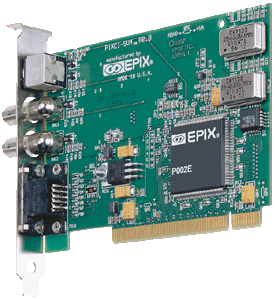
Introducing . . . . .

Image Capture Board For The PCI Bus


 PIXCI derived from "EPIX PCI", is our first PCI compatible
imaging board. It provides an economical imaging solution by taking maximum
advantage of the computer's resources. The PIXCI® board uses the computer's
RAM for image memory, the computer's CPU for image processing, and the computer's
S/VGA system for image display. PIXCI® provides image capture from
S-Video, NTSC, or PAL color video formats, as well as RS-170 and CCIR monochrome.
PIXCI derived from "EPIX PCI", is our first PCI compatible
imaging board. It provides an economical imaging solution by taking maximum
advantage of the computer's resources. The PIXCI® board uses the computer's
RAM for image memory, the computer's CPU for image processing, and the computer's
S/VGA system for image display. PIXCI® provides image capture from
S-Video, NTSC, or PAL color video formats, as well as RS-170 and CCIR monochrome.
Image Memory
PIXCI® uses the computer's memory to store images. The bandwidth of the PCI bus allows PIXCI® to move image data directly into the computer's RAM and maintain a 30 frame per second capture rate until the computer's RAM is full. As a result, PIXCI® does not need on-board image memory.
Image Processing Speed
EPIX won't be publishing image processing benchmarks for PIXCI because it doesn't process images - the computer does! The PIXCI board's responsibilities end after the images are delivered to the PCI bus.
Image Display
Image display capabilities, similar to processing capabilities, are dependent on the controlling software and the computer's hardware resources. The PIXCI® board has no direct involvement. For clarity, the following paragraphs separately discuss monochrome and color display capabilities:
Monochrome Display
In the DOS environment, EPIX software displays monochrome images on a VESA 1.0 compatible display adapter. A 640x480 VGA display is limited to a depth of 4 bits (16 grey levels). Use of a Super VGA system provides a full 256 grey level display. EPIX Windows software provides display on any S/VGA adapter supported by Windows. Frame rate, in either case, can reach 30 Hz.
Color Display
Twenty-four bit RGB display is available under both DOS and Windows on most systems which are capable of 24 bit RGB display. Processing is required before the image is displayed - the color image, captured as YCrCb color, must be converted into 24 bit RGB color. EPIX does not expect current Pentium computers to provide 30 frame per second RGB display at 640x480 resolution.
PCI Master Control
PIXCI® is a PCI Bus and Target Master. The PCI Master capability means that the PIXCI® board controls data transfers onto the PCI bus - it does not wait for the computer's CPU to read images from the board into PC memory. Nevertheless, PIXCI® has no control over data transfer rates. Data transfer rates are regulated by the computer's PCI chip set.
I/O Capabilities
A DB-15 connector provides 4 TTL level inputs as well as 4 TTL level outputs. With appropriate software, TTL input bits allow external devices to trigger PIXCI® operations. TTL output bits allow PIXCI® to control external devices.
Software Support
As with the 4MEG VIDEO and SILICON VIDEO MUX series of imaging boards, PIXCI® will be supported with a full complement of software. Windows as well as DOS compatible products will be offered. PIXCI must be accessed from a 32 bit protected mode environment. As a result, 16 bit C compilers, as offered by Microsoft and Borland, won't work. EPIX supports the Watcom (32 bit) compiler with Rational Dos Extender, and offers Windows DLLs. These packages control I/O functions, capturing of sequences, image processing operations, image measurement, and display.
Availability
Developers, intent on developing their own custom software, are invited to
contact EPIX to determine the availability of
Beta Test boards. The availability of production boards, as well as fully documented
software, will be announced soon.
EPIX Vision - March 1996 Newsletter
Specifications and prices subject to change without notice.
EPIX® imaging products are made in the USA.
Copyright © 2025 EPIX, Inc. All rights reserved.